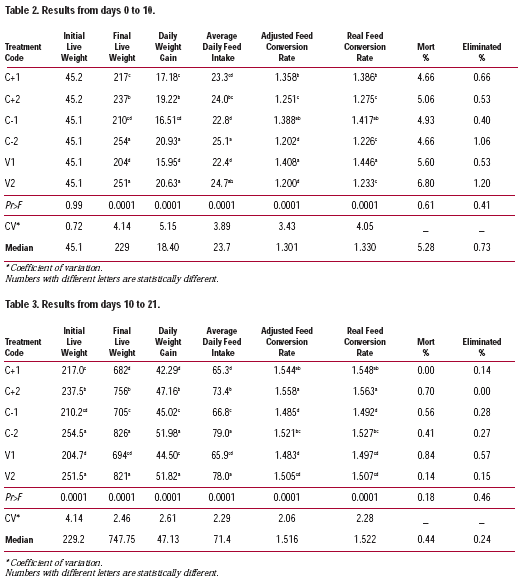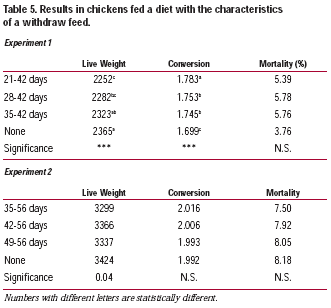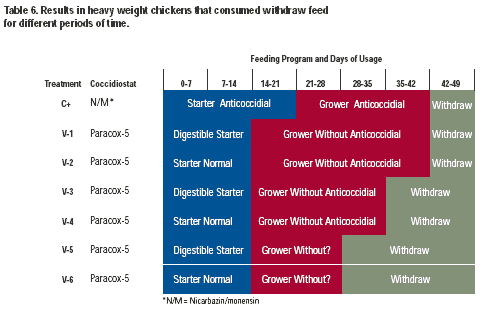COCCI Nutrition: Cocci vaccination enables more flexible diet
Review your program to minimise coccidiosis pressure and maximise control
 Dr. José Ignacio Barragan,
Poultry Veterinarian and Independent Nutritional Consultant, Spain |
As long as commercial poultry
operations have been in existence,
nutritionists have tried to
appraise the impact of feed nutrients
and the changing dietary needs of
broilers. They have also sought to find
and control anti-nutrition factors present
in the feed.
In many cases, nutritional needs are
linear but diminish as chickens grow
older. In other words, as birds age, the
dietary contribution of the feed differs
and, in general, diminishes.
An important factor to consider is
the chicken's sensitivity to the diet's
energy level. There is practically a linear
relationship between energy levels
in the diet and the feed conversion
index. Since the feed conversion index
is the most important factor affecting
the cost of broiler production, it is generally
the first element defined by nutritionists.
Once this value is established,
remaining nutrients are defined in
terms of the estimated consumption
according to the energy level and the
needs of the production phase.
Another important dietary decision
is the length of time that each feed type
should be used. First consider the number
of feed types that the mill can manufacture
based on its capacity and the
logistics involved. In general, feed mills
usually handle three different broiler
feed types and, under certain circumstances,
four, but it is usually difficult to
increase this amount. Generally, the
more types of feed that can be manufactured,
the better the nutritional
needs of chickens can be met. On the
other hand, the mill's capabilities are
usually considered before cost optimization.
Once the amount of different broiler
feed types is established, the age
limits for the use of each feed must be
determined. In theory, this should be
the most economical feeding program.
In reality, though, the feeding program
is significantly influenced by the anticoccidial
program.
Traditional programs
For years in Spain and many other
countries with a long tradition of poultry
farming, the coccidiosis control program
consisted of a chemical product,
which generally was nicarbazin during
the first weeks followed by an
ionophore (e.g., monensin, salinomycin).
The optimum period of time
that nicarbazin can be used is 21 days,
since less time reduces its efficacy,
while more increases the risk of growth
depression; in addition, different regulations
require that this anticoccidial be
withdrawn a certain number of days
before slaughter.
As a result, the more universally
used formulation programs have had a
starter feed until 21 days of age, a
grower feed until a few days before
slaughter (depending on the regulations)
and a withdrawal feed until
slaughter. This is the way it has been
done, even though it may not be the
most technically or economically ideal
program.
The situation differs when chickens
are vaccinated to control coccidiosis.
The length of time that finisher feed is
used is not determined by concerns
that chickens will suffer from coccidiosis
in the late "and expensive -
grow-out period. These new circumstances
also allow feed to be formulated
for times that the chicken's intestines
are battling Eimeria introduced by
the vaccine, which is the period
between 15 and 25 days of age.
Vaccinated birds
Feeding programs for chickens vaccinated
against coccidiosis should have
three different objectives. They should:
Develop the immunological system.
The feed should promote
growth and good immunity system
function.
 |
Provide birds with the best
defense for replication periods
by providing good digestibility and,
when possible, preventing other
complicating factors such as necrotic
enteritis.
Utilize the resistance to coccidiosis
created in birds to maximize
growth for the lowest cost possible
in the final grow-out period.
This triple objective can be achieved
more easily with a feeding system that's
different from the one used now. It
would provide the use of:
- An "impulse" (pre-starter) feed from 0 to 14 days of age
- A highly digestible feed from 15 to 30 days
- A technically and economically useful feed from 31 days until slaughter.
Field trials
To test this new diet, trials were conducted
at one of the most prestigious
experimental farms in Spain. In one
trial, 4,500 Hybro males were used. The
birds were divided into three groups:
those that received an anticoccidial,
those that did not, and those that were
vaccinated against coccidiosis. Among
each of the three groups, half received
the conventional diet and half received
an alternative diet (Table 1).
The conventional feeding program
consisted of the following feed types:
- P1: Starter. From 0 to 21 days, with 3020 Kcal; 23.6% total protein and 1.1% of available lysine.
- P2: Grower. From 21 to 42 days, with 3250 Kcal; 23% protein and 1.05% of available lysine.
- P3: Finisher. From 43 to 49 days, with 3250 Kcal; 21.9% protein and 0.95% of available lysine.
- P1 feed was given as crumbs and P2 and P3 as granules.
- P0: A pre-starter from 0 to10 days, with 3000 Kcal; 24% protein and 1.3% of available lysine.
- P1: A starter from 11 to 21 days, 2850 Kcal; 23% protein and 1.04% of available lysine.
- P2: A grower.
- P3: A finisher.
 |
 |
The goal of the alternative diets was
to ensure the best possible start for
chickens and to facilitate digestibility
during the first 21 days of age with a
less concentrated feed. Results for the
period from 0 to 10 days are presented
in Tables 2, 3 and 4.
The results show that body weights
at 10 and 21 days and at the end of the
trial are higher in birds fed with the
program consisting of a pre-starter and
a more digestible starter compared to
those fed the standard program. These
differences are significant in all three
production periods as well as in the
three coccidiosis control programs
(anticoccidial, no anticoccidial and vaccinated).
The largest appreciable difference
in numbers regarding final bodyweight
was seen in the vaccinated
group.
The feed conversion ratio tends to
be slightly worse, though not truly significant,
in chickens fed the alternative
program due to higher feed consumption.
However, this slight increase in
feed consumption does not limit the
opportunity for final weight increase
using the alternative program. The
slightly increased cost of feed with the
alternative program for the initial stages
is due to the higher concentration of
amino acids and improved characteristics
of the feed ingredients.

|
To reduce the cost of feed and better
utilize the immunity obtained
against coccidiosis in vaccinated chickens,
it is possible to modify the duration
of the "third stage" feed (generally
known as "withdraw" feed because it
coincides with the withdrawal period of
the growth promoters and coccidiostat).
Studies by Saleh, Watkins and Waldrop
have shown that, in high bodyweight
chickens, a diet with the characteristics
of a withdraw feed can be used for
longer periods without affecting the
technical results (Table 5).
We can see that increasing the use
of withdraw feed in birds of medium
bodyweight up to 14 days reduces the
average weight in birds that received
only grower, but not withdraw feed.
However, when the test is repeated in
heavy weight birds, there is no difference
between chickens that consumed
7 or 14 days of withdraw feed.
With these results in mind, a trial
was repeated at the same location of
the first trial. The results for chickens
with different withdrawal periods are
compared in Table 6.

|
A standard feeding program containing
anticoccidials is compared with
a series of alternative programs in vaccinated
chickens consuming a first feed
with two variations (normal and higher
digestible, with lower levels of energy
and protein/amino acids) and a second
and third feed of variable duration,
increasing the withdrawal period
(Table 7).
The results show there is no difference
between chicken weights regardless
of the withdrawal period used or
the feed conversion rate, even though
it is numerically better in chickens that
received the feed from 35 days of age.
This test was unable to establish differences
between the chickens that
received the two different first stage
feeds, even though, numerically, the
weights of chickens fed the more digestible, but less concentrated, feed
were slightly lower. Neither was it possible
to find differences between the
processing results among chickens in
the different treatment groups, nor in
the values of litter quality or in Eimeria
oocysts counts.
In the end, there were no significant
differences between the results of the
vaccinated and the anticoccidial-fed
control groups.
From these trials, we can conclude
that in chickens vaccinated against coccidiosis,
it is possible to extend the time
that finisher (withdrawal) diets are used
if final weight will be higher than 2.4 kg
(5.28 lbs), without having detrimental
effects.
On the other hand, a starter diet
with special characteristics may allow
the birds to have a better "start" with
improved resistance during the period
of higher Eimeria replication.
 |
Conclusion
Using an "impulse" starter feed, a highly
digestible second stage diet fed
between 15 and 25 days of age along
with a finisher diet fed for a longer period
of time than usual can better meet
the needs of chickens vaccinated
against coccidiosis.
Once liberated from the limits established
by the use of a traditional anticoccidial
program, poultry producers
can have more freedom designing feed
formulas and programs. Alternative
programs might also benefit vaccinated
chickens by providing them with better
intestinal health, without increasing the
cost of the feeding program.
Source: CocciForum Issue No.8, Schering-Plough Animal Health.







